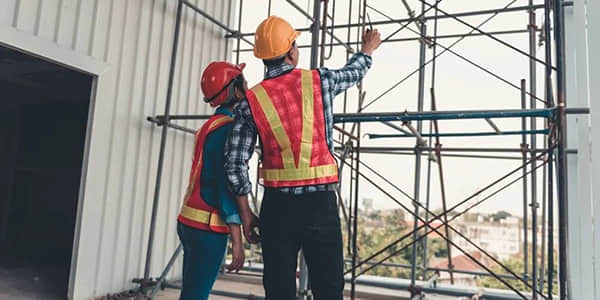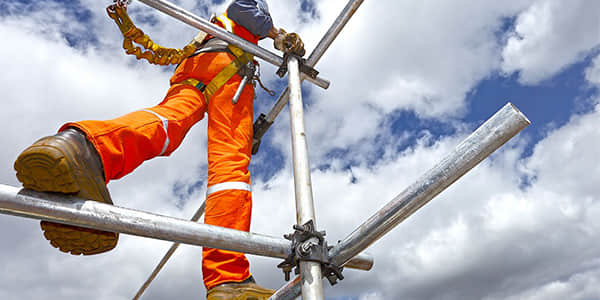Top 5 Scaffolding Safety Requirements to Prevent Accidents
Aug 23, 2025Working at height has its hazards, even in the construction sector, where scaffolding is an invaluable means to reduce risk. However, scaffolding and scaffold-related incidents and accidents are a major contributor to safe working responsibilities and duties, and injury-related fatalities in construction. According to the U.S. Bureau of Labor Statistics, scaffold-related incidents, or accidents, will occur every day, accounting for thousands of injuries or deaths each year. In fact, most severe incidents causing injuries are end products of falls. These are just statistics; as we all know, they are tragedies that could be avoided if the right knowledge, tools, and commitment to safety protocols are in place and consistently followed.
It is not only the responsibility of the scaffolding contractor to understand proper scaffolding safety procedures and protocols, but it is also the responsibility of the project manager, construction worker, and supplier of building materials and scaffolding. We must do this to protect workers, businesses, and/or projects from harm.
Here are five key scaffolding safety tips that can significantly lessen risks and help create an atmosphere of confidence and safety on your site.

A scaffold is only as safe as its last inspection. You wouldn't drive a car without checking its tires and brakes, so don't let your crew work on a scaffold without a thorough check. Inspections are your first line of defense against structural failures and component damage.
OSHA requires that a "competent person" conduct a pre-shift inspection of the scaffold, and when there is an event that could affect the integrity of the scaffold, such as a high wind event, heavy or prolonged rain event, or a major shift in load. So what exactly is a "competent person"? A competent person is someone who is able to recognize existing and predictable hazards in the work environment and has the authority to take immediate corrective actions to eliminate the hazards through experience and training.
What to Check? A Daily Checklist:
A scaffold is basically a miniature building. Without a solid foundation, the entire scaffold will be compromised. Poor assembly, as well as an inadequate foundation, are big causes of scaffold collapses. This is the part where you need to be very meticulous.

Falls are the primary cause of death in scaffold-related accidents. Having a substantial fall protection system is the best way to prevent these accidents, and this includes more than a single piece of equipment.
Guardrails are Required. Guardrails, midrails, and toe boards are required on all open sides of any scaffold platform that is 10 feet or more above a lower level. Each guardrail must be between 38-45 inches above the platform, and the midrail must be halfway between the platform and the top rail.
Personal Fall Arrest System (PFAS): In situations where guardrails are not feasible (e.g., while erecting or dismantling the scaffold), a PFAS is mandatory. This system includes a full-body harness, a shock-absorbing lanyard, and an anchorage point that can support at least 5,000 pounds per employee.
Safe Access: Employees are prohibited from climbing on cross braces or diagonal members. Always use the proper access points, ladders, or stairways. Scaffolds must be set up to allow for safe access for all employees to all levels.
Overloading a scaffold is an invitation for disaster. Scaffold capacity is reduced based on load ratings as they are designed, so if you exceed any load rating on a scaffold while loading it results in the possibility of a catastrophic collapse.
Recognize the difference: It is very important to recognize the difference between working load and design load. The working load is the total weight of the worker, tools, and materials. The design load is the maximum load that a scaffold has been designed for, using a considerable safety factor. For example, the working load on a light-duty scaffold is 25 lbs/sq ft, while the design load is 125 lbs/sq ft because of the safety factor of 5.
Distribute Evenly: Distribute the weight of workers, tools, and materials evenly across the platform. You should not pile materials in one concentrated area, as this has created a "point load," which the scaffold may not be designed to carry safely.
Just-in-Time Delivery: The scaffold is not designed to be a storage unit, so do not use it as a long-term storage space. Only bring up materials and tools for the job you are currently doing. This will minimize the load.
A scaffold is only as safe as the people who use it. The best equipment in the world is useless without a well-trained, knowledgeable crew.
Need-to-Know Training: A person must have completed training by a qualified person; everyone who uses a scaffold; recognized training should not only include those assembling and disassembling scaffolds, but also those merely using a scaffold.
What to Learn? Training should cover all potential hazards—including falls, electrical hazards, and falling objects. It should also include a detailed understanding of the scaffold's proper use, handling of materials, and emergency procedures. Specifically, workers should be trained on how to properly inspect the scaffold themselves, how to use and care for their personal protective equipment (PPE), and what to do if they spot a potential hazard.
Continuous Learning: Safety isn't a one-time lesson. Ongoing training, refreshers, and regular safety meetings ensure everyone stays current with regulations and reinforces a safety-first mindset.
Following these five critical safety tips is not just about meeting regulations; it's about protecting lives, maintaining project schedules, and building a reputation for excellence. A safe work environment is a productive work environment. By making safety a core value, you protect your most valuable assets—your people. It's an investment that pays dividends in morale, efficiency, and a project completed with confidence.
Partner with a company that puts safety first. We are committed to providing not only top-quality scaffolding and equipment but also the expert knowledge and support you need to ensure a secure and compliant work site. Contact us today to learn more about our OSHA-compliant scaffolding solutions and safety training programs.
Can I mix and match scaffold components from different manufacturers?
Who is responsible for scaffolding safety on a job site?